Travel with me #62 :The magnificent ancient Bell and Drum Towers of Xi'an
Dear Steemit Friends:

In today's expedition, we'll be having a little tour of not one, but two of the most grandest buildings in all of China. They are none other than the Bell and Drum towers in Xi'an of the Shaanxi province. For centuries, these towers have served as symbols of the old capital. Reminding all who visit or inhabit the city of it's grand heritage.
The Bell and Drum towers are situated in the central district of Xi'an and are often called sister buildings because they bear some aesthetic similarities and were also constructed roughly around the same time.
Both the Bell and Drum towers were constructed in the Ming Dynasty (1368 - 1644) with the Drum tower completing four years before the completion of the Bell tower. Together they have accumulated more than 600 years of history.
The Bell tower is named as such because at the top of the building, it used to house a gigantic bell which was used to ring at set times in the day to let people know the correct time. It was also used to call upon people for announcements, or give early warnings for attacks on the city.
The drum tower had a similar function, within the building it houses a huge drum which was usually struck at dawn to wake people up, and again at sunset to indicate the end of day, and time for rest. Actually, the idiom morning bell, evening drum, monastic practice which means encouragement to study or progress, originated from the bell and drum towers.
In the ancient times, people could tell the time of day from hearing the number of rings on the bell, or strikes on the drum. I believe the bell and drum towers brought a lot of convenience and order to the ancient people who lived here.

Both the Bell and Drum tower are constructed with brick and timber. The drum tower is two stories tall, and has a rectangular brick-structured pedestal of roughly 50m. Because of this large base, it appears to be much bigger and taller than the bell tower. In ancient times, there were no speakers and so in order for the sound of the drum to be heard from far away, the drum tower was built as tall as possible. In the picture, you can see the drum tower in the background.
The drum tower is to this day, the largest drum tower in all of China.
This is the rear side of the drum tower.
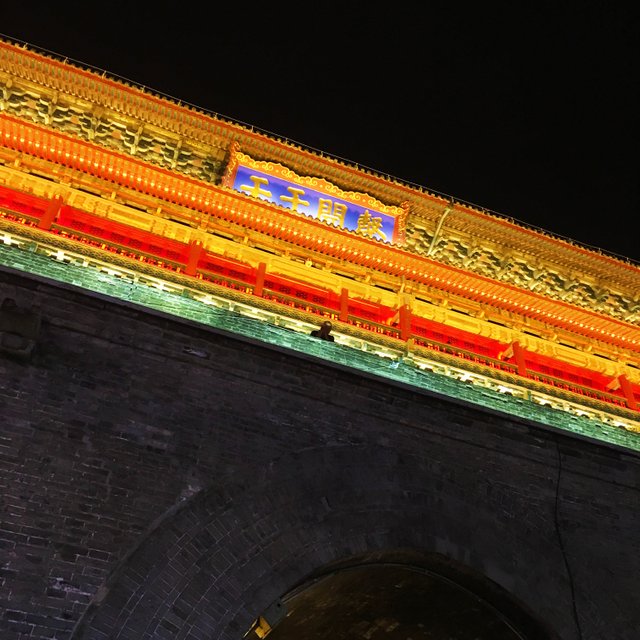
On the north side of the tower, is the lively, bustling and infamousHuimin Street,each day, drawing visitation from thousands of foodies alike.
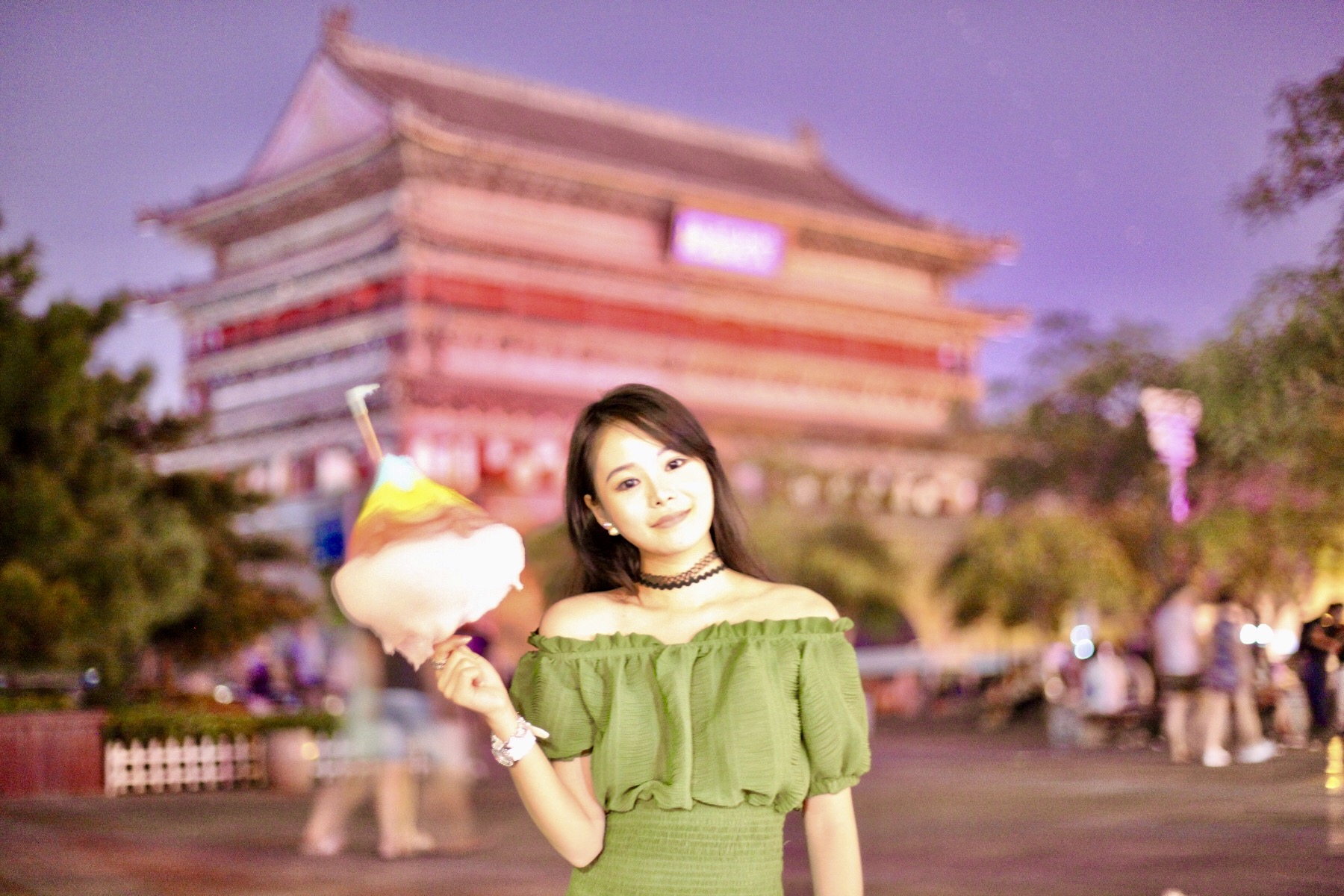

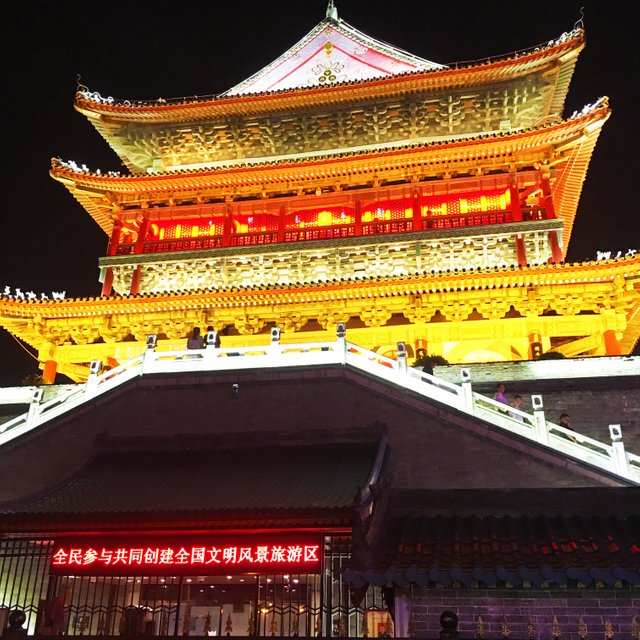

There are many legends surrounding the origin of the Bell tower, but a popular one that i've heard is that the city was once in perpetual danger of flooding due to a great river flowing through the center of the city. At the center, there lived a giant turtle monster. Each time it moved, it would create massive waves causing floods to the dwellers of the city. In order to ensure their future safety, the ancient people invited their best craftsmen to build the bell tower and use the giant turtle to cover the river opening. Eventually, the city returned to sea level with the turtle locked up in chains, blocking further leaks and causing no more waves.
Some people say that if you go to the ground level of the bell tower in the dead of the night, you can hear the sound of the sea, but listening closely, you can even hear the sound of the giant turtle snoring!
Of course, the legend ignites some curiosity over what is actually in the bell tower, so let's go inside and take a look.
Going up the tower, at the north west corner, you can see this huge bell.

This bell is by one of the doorways to inside the tower. Either side of the doorway, you can see the rhyming couplets and the large plaque describing the Jingyun bell.
The view from a top the tower is very broad. In fact, you can almost see the entire inner city. This is because the bell tower is actually at the center of the inner city. On all four directions, you can see the city gates.
Standing on one of the city tower gates, you can see the drum tower behind me. In Xi'an, all the new buildings in the inner city must conform to the architectural style of the bell tower and city wall. This is to try retain the traditional aesthetic of the ancient city.

Opposite, you can see an example of one of these new buildings within the inner city. A large shopping center which although clearly is a modern building, retains much of the classical look and feel of the ancient city style.
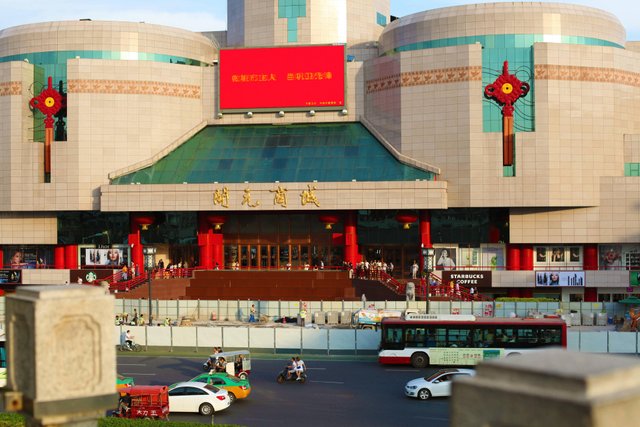
I really like the characters on this pillar. Compared to the modern day simplified Chinese characters, they seem a lot more delicate and beautiful.

In the main hall, up on the stage, you can see a row of bells from the Qin dynasty. these are considered highly precious treasures of the bell tower. Beside them, you can see some bright red drums.
Sometimes there are classical Chinese ensembles performing live here. If you're lucky, you might be able to catch one of their performances here.

The ceiling of the main hall is decorated beautifully.

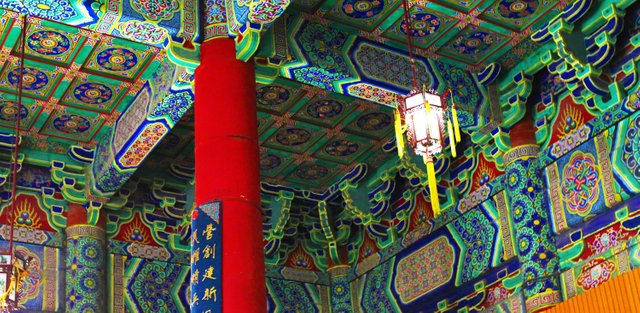

Exiting the bell tower, I came across this little stall just outside selling 3D Chinese paper cut outs of the bell tower. Look at that incredible detail!
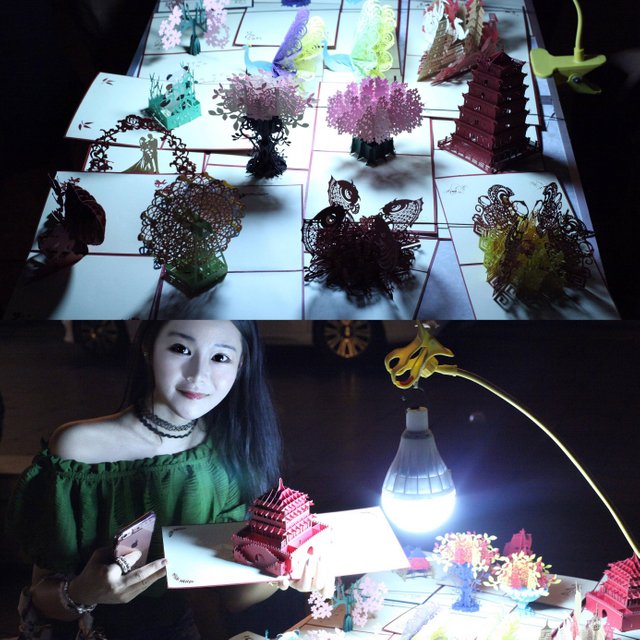
Paper cutting is also known as a distinguishing art form from North West China (Shaanxi, Gansu, Qinhai, Ningxia, Xinjiang etc.)

What an amazing work of art wouldn't you say? It's so detailed, and it's collapsable too. None of it requires glue and it'll stand up into 3D just by opening it up.
And that concludes today's expedition to the Bell and Drum towers in the heart of Xi'an.
I hope you all enjoyed it and stay tuned for more !
Be sure to leave a comment, and don't forget to upvote and follow me if you haven't already!
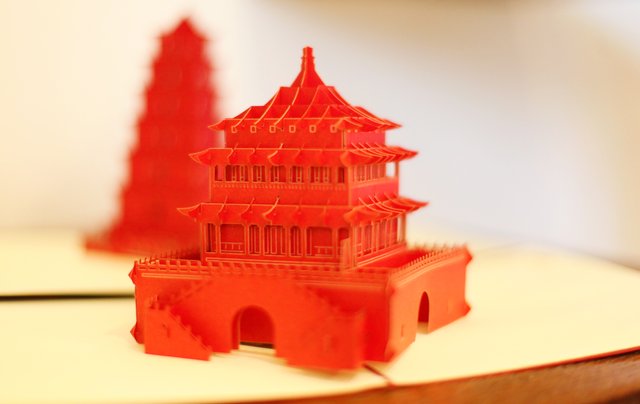
今天这篇文章,我想带大家飞去中国陕西西安,领略一下西安标志性建筑物,钟楼和鼓楼的风采。钟鼓楼建在西安市的市中心,被称为姊妹楼, 相距仅半里,钟楼和鼓楼遥想呼应,一起见证着这座城市的发展。钟鼓楼都是建于明代,鼓楼比钟楼早建造4年,到今天已有620多年的历史。
之所以叫钟楼和鼓楼是因为,钟楼上古代的时候,挂着一口大钟,用于报警和报时或者发布消息,鼓楼上原来也有一面巨鼓,每天定点击鼓报时。古代时候讲究早晨敲钟催人醒来,晚上击鼓提醒人们睡觉,成语晨钟暮鼓就是这么来的。并且智慧的古代人会依据钟声和鼓声敲击的次数判断时间的早晚。钟楼和鼓楼都是以砖木结构为主,但是鼓楼的方型底座要比钟楼大很多, 所以钟楼看上去更高大。因为古代人为了让鼓声能传遍全城,所以建造了高楼设置大鼓。我身后就是夜晚金光闪闪的鼓楼了。听说鼓楼是所存在中国最大的鼓楼。鼓楼的背面。在鼓楼的北边,就是热闹喧嚣的回民街,每天在这条街上,都挤满了来自世界各地的吃货们。关于钟楼的存在,我还听说过这样一个有趣的传说。传说在很久以前,西安被淹没在大海之中,而海水不是河流汇聚而成的,而是从钟楼位置的泉眼涌出来的。海里有只几亿岁的巨型乌龟整天闹腾。乌龟只要一动,就会出现巨浪。当时这片土地的祖先依靠山和水居住,所以他们的住处遭到水淹。为了保证他们的安全并且不再有水灾,祖先们请来神仙工匠,修建了钟楼盖住泉眼。为了保证巨型乌龟不再闹事,就用锁锁住它,把它巨大的身体堵住泉眼,使海水不再冲出。之后西安这座城市才渐渐露出海平面。听说每当半夜,夜深人静的时候,如果你爬到钟楼附近的地上仔细听,还能听见海水的声音,还有巨型乌龟睡觉的鼾声。
听了这个传说,让我更加对钟楼充满了好奇,我从来没有想象,钟楼背后的传说是这么神奇而美好。现在就请大家跟随我的步伐,爬上钟楼看看钟楼里都有什么。走上钟楼,立刻看到钟楼西北角有一口大钟。这口钟就是楼门口对联上写的景云钟。钟楼上视野很广,可以跳望整个西安城。因为钟楼位于西安城的中央,东西南北4个方向都可以看到西安城墙(城墙1,城墙2)的4个城门。在西安,所有的新建筑都被i要求外墙做成和钟楼城墙相匹配的古建筑的风格,让整个城市的氛围相协调。站在城楼上,可以清晰地看见对面的商场,这个商场也装扮得非常古典的样子。我很喜欢这个门上的字,和现在的简体汉字不太一样,更加精美漂亮。走进正厅,舞台排着一台秦朝时期的大钟,这是钟楼的镇楼之宝。边上摆着鲜红色的大鼓,有时候在这里还可以欣赏到古代乐器演奏表演。厅里漂亮的壁画吊顶。在城楼下我还发现了这个可爱的小铺子,在卖立体剪纸的钟楼。剪纸也是西北最有特色的民间工艺了。仔细看非常精致,不需要任何胶水,就可以轻松的让一座城楼立起来了。希望大家喜欢我今天的探索,之后还有更多有趣的中国特色要介绍给大家。

Reading the whole publication and observing such beautiful images I declare myself faithful follower of you, it is beautiful the work that you present. You really learn about the culture of the place.
Thank you haydeart, i do my best to share my culture with everyone. I'm very happy you find interest in that.
Thanks you
wow ceiling!
and paper cuttings - someone has that much patience to do all that
I think exactly the same! Like it a lot!
your quite possibly one of the best travel bloggers on the internet, not just on steem, the level of professionalism you bring to blogging as a brand advocate for a city alone is on the level that agencies should copy. props for your work. always love to see your pictures of those places.
wow, i'm really humbled by your appraisal, thank you so much, it's both an honour and pleasure :)
I totally share the opinion @ teamhumble, you are very profecional in what you do is what I admire of your work.
have a beautiful day
I am the first one to vote!!!
Thank you cqf!
Haha-Hoho-hihi :)
sorry to let you know: from steemd.com... you voted 3 seconds later than the first voter. :) but you ARE the first one to comment.
deanliu on top form
hate myself for that ... lol
Glad you let me know :) I will try to the first next time :)
Wow, lovely lovely post.
I love your cap also.
thank you timoshey, full steemit attire!
Great post and I loved those little folding paper ones at the end, so detailed!
thanks meesterboom! The folding paper was such a nice souvenir to take away, almost as amazing as the real thing!
Your welcome! They do look like fantastic souvenirs!
They look amazing at night!
It is amazing the architectural masterpieces that are in China.
I agree, I think at night time, the lighting really makes the towers seem that much more beautiful. During the day, they can seem quite gloomy actually.
This is actually one of the most beautiful photo reportage on Steemit!
Thank you ! That's a high honour ! :)
Once the terminus of the Silk Road and a melting pot of cultures and religions, as well as home to emperors, courtesans, poets, monks, merchants and warriors, the glory days of Xī’ān (西安) may have ended in the early 10th century, but a considerable amount of ancient Cháng’ān, the former city, survives behind the often roaring, modern city. Xī’ān’s Ming-era city walls remain intact and are a MUST SEE! Great to see you back home in this great city @sweetsssj :)
you know your Chinese history quite well mindhunter, i'm very impressed :)
Chinese hips and history - a @mindhunter speciality - China has a very special place in my heart @sweetsssj.<3
Nice blog :-)
thank you moksamol !
Congratulations @sweetsssj!
Your post was mentioned in my hit parade in the following categories: